Banking Exams Exam > Banking Exams Questions > Read the following information carefully and...
Start Learning for Free
Read the following information carefully and answer the question given below:23th
There are 10 persons – P, Q, R, S, T, U, V, W, X and Y had exams on dates 9th, 14th, 23th
and 26th of each month – March, April, May and June but not necessarily in the same order. Not more than three persons have exam on same date and same month. Each person had different score viz. 16, 19, 21, 8, 9 and 10 but not necessarily in the same order.
The one who had exam on even number date scored 21. The one who had exam in March had a score of 8. P had exam on 23th. T scored two times that of W but does not have exam in same month. Q had exam on even number month. V’s exam was not in May. Only Y had exam in the month of June on 26th and scored 10 marks. Neither X nor W had exam in March. R had exam on 14th and had a score equal to the square of month number. S had exam on even date and in even month. T had exam on prime date and in prime number month. W had scored 6 marks less than his date of exam. The one who had exam on 23th had a prime score. The one who had exam earlier than Q had scored 5 marks more than its month number. X had scored same as sum of T’s score and its month number. The one who had exam after W had scored two times that of W. U had exam on date such that it is the square of earlier month number.
Q. What is the sum of scores of U and P?
- a)37
- b)17
- c)27
- d)25
- e)28
Correct answer is option 'D'. Can you explain this answer?
Most Upvoted Answer
Read the following information carefully and answer the question give...
Persons – P, Q, R, S, T, U, V, W, X and Y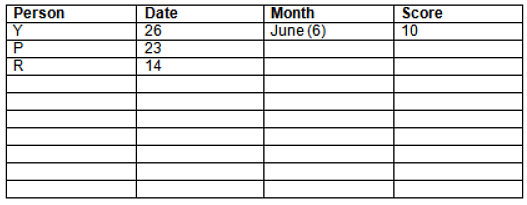
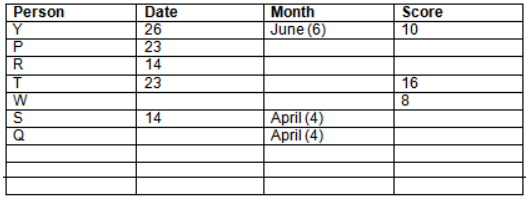
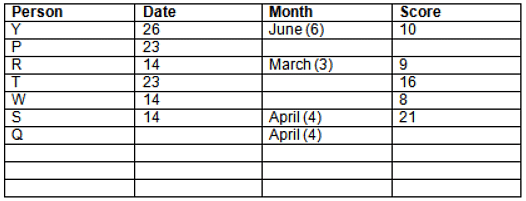
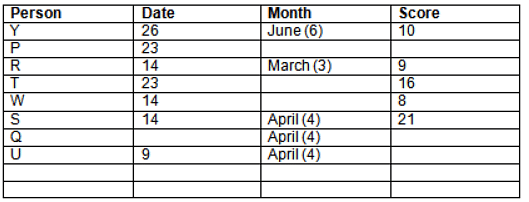
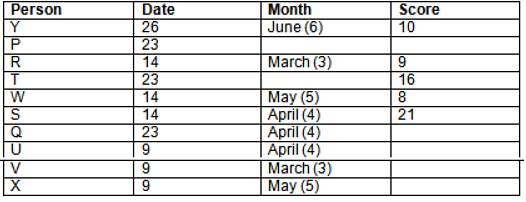
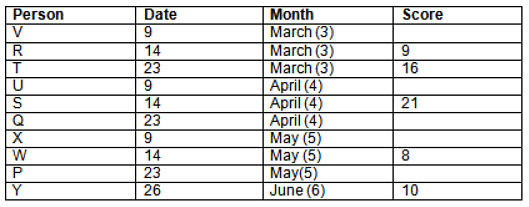
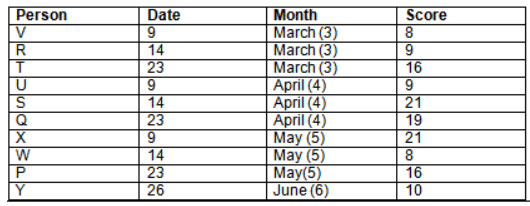
Date – 9, 14, 23 and 26
Month – March, April, May and June
Score – 16, 19, 21, 8, 9 and 10
1. Only Y had exam in the month of June on 26 and scored 10 marks. P had exam on 23. R had exam on 14 and had a score equal to the square of month number.

2. T scored two times that of W but not in same month. T had exam on prime date and in prime number month.
Hence, T scored 16 marks and W scored 8 marks. T had exam on 23.
S had exam on even date and in even month.
Hence, S had exam on 14th and in April.
Q had exam on even number month.
Hence, Q had exam in April.

3. W had scored 6 marks less than date of exam.
Hence, W scored 8 marks and had exam on 14.
The one who had exam on even number date scored 21. R had exam on 14 and had a score equal to the square of month number.
Hence, S scored 21 marks and R scored 9 marks and had exam in March

4. U had exam on date such that it is the square of earlier month number.
Hence, U had exam on 9th April.

5. V’s exam was not in May. Neither X nor W had exam in March.
Hence, V’s exam was in March and X and W had exam in May. Q exam was on 23. V and X exam was on 9.

6. The one who had exam earlier than Q had scored 5 marks more than its month number.
As Q had exam on 23rd April and U had exam on 9th April. So, U scored 9 marks.
T scored two times that of W but not in same month.
Hence, T had exam in March.

7. The one who had exam after W had scored two times that of W.
As W exam was on 14th May so P scored 16 marks.
The one who had exam in March had a score of 8.
Hence, V scored 8 marks.
X had scored same as sum of T’s score and its month number.
Hence, X scored 16 + 5 = 21 marks.
The one who had exam on 23 had a prime score.
Hence, Q scored 19 marks.
The one who had exam earlier than Q had scored 5 marks more than its month number.
Hence, U had exam earlier than Q and scored 5 + 4 = 9 marks.

Hence, the sum of scores of U and P is 25.
Free Test
FREE
| Start Free Test |
Community Answer
Read the following information carefully and answer the question give...
Step-by-step explanation:
Given information:
- P had exam on 23rd.
- T's score is two times that of W's score.
- Q had exam in an even-numbered month.
- V's exam was not in May.
- Y had exam in June on the 26th and scored 10 marks.
- R had exam on the 14th and scored a square number.
- S had exam on an even date and in an even month.
- T had exam on a prime date and in a prime number month.
- W's score is 6 less than the date of the exam.
- The person who had an exam on the 23rd scored a prime number.
- The person who had an exam before Q scored 5 marks more than the month number.
- X's score is the sum of T's score and the month number.
- The person who had an exam after W scored twice as much as W.
- U had an exam on a date that is a square of an earlier month number.
Analysis:
- From the given information, we can deduce the following:
- T's score must be 21, as it was on an even-numbered date.
- W's score must be 8, as it was in March.
- R's score must be 16, as it was a square number.
- S's score must be 19, as it was on an even date.
- Q's score must be 10, as it was in an even month.
- X's score must be 23, as it is the sum of T's score and the month number.
- U's score must be 9, as it was on a prime number date.
Calculations:
- The sum of scores of U and P would be 9 (U) + 16 (P) = 25.
Therefore, the sum of scores of U and P is 25.

|
Explore Courses for Banking Exams exam
|

|
Similar Banking Exams Doubts
Read the following information carefully and answer the question given below:23thThere are 10 persons – P, Q, R, S, T, U, V, W, X and Y had exams on dates 9th, 14th, 23thand 26th of each month – March, April, May and June but not necessarily in the same order. Not more than three persons have exam on same date and same month. Each person had different score viz. 16, 19, 21, 8, 9 and 10 but not necessarily in the same order.The one who had exam on even number date scored 21. The one who had exam in March had a score of 8. P had exam on 23th. T scored two times that of W but does not have exam in same month. Q had exam on even number month. V’s exam was not in May. Only Y had exam in the month of June on 26th and scored 10 marks. Neither X nor W had exam in March. R had exam on 14th and had a score equal to the square of month number. S had exam on even date and in even month. T had exam on prime date and in prime number month. W had scored 6 marks less than his date of exam. The one who had exam on 23th had a prime score. The one who had exam earlier than Q had scored 5 marks more than its month number. X had scored same as sum of T’s score and its month number. The one who had exam after W had scored two times that of W. U had exam on date such that it is the square of earlier month number.Q. What is the sum of scores of U and P?a)37b)17c)27d)25e)28Correct answer is option 'D'. Can you explain this answer?
Question Description
Read the following information carefully and answer the question given below:23thThere are 10 persons – P, Q, R, S, T, U, V, W, X and Y had exams on dates 9th, 14th, 23thand 26th of each month – March, April, May and June but not necessarily in the same order. Not more than three persons have exam on same date and same month. Each person had different score viz. 16, 19, 21, 8, 9 and 10 but not necessarily in the same order.The one who had exam on even number date scored 21. The one who had exam in March had a score of 8. P had exam on 23th. T scored two times that of W but does not have exam in same month. Q had exam on even number month. V’s exam was not in May. Only Y had exam in the month of June on 26th and scored 10 marks. Neither X nor W had exam in March. R had exam on 14th and had a score equal to the square of month number. S had exam on even date and in even month. T had exam on prime date and in prime number month. W had scored 6 marks less than his date of exam. The one who had exam on 23th had a prime score. The one who had exam earlier than Q had scored 5 marks more than its month number. X had scored same as sum of T’s score and its month number. The one who had exam after W had scored two times that of W. U had exam on date such that it is the square of earlier month number.Q. What is the sum of scores of U and P?a)37b)17c)27d)25e)28Correct answer is option 'D'. Can you explain this answer? for Banking Exams 2025 is part of Banking Exams preparation. The Question and answers have been prepared according to the Banking Exams exam syllabus. Information about Read the following information carefully and answer the question given below:23thThere are 10 persons – P, Q, R, S, T, U, V, W, X and Y had exams on dates 9th, 14th, 23thand 26th of each month – March, April, May and June but not necessarily in the same order. Not more than three persons have exam on same date and same month. Each person had different score viz. 16, 19, 21, 8, 9 and 10 but not necessarily in the same order.The one who had exam on even number date scored 21. The one who had exam in March had a score of 8. P had exam on 23th. T scored two times that of W but does not have exam in same month. Q had exam on even number month. V’s exam was not in May. Only Y had exam in the month of June on 26th and scored 10 marks. Neither X nor W had exam in March. R had exam on 14th and had a score equal to the square of month number. S had exam on even date and in even month. T had exam on prime date and in prime number month. W had scored 6 marks less than his date of exam. The one who had exam on 23th had a prime score. The one who had exam earlier than Q had scored 5 marks more than its month number. X had scored same as sum of T’s score and its month number. The one who had exam after W had scored two times that of W. U had exam on date such that it is the square of earlier month number.Q. What is the sum of scores of U and P?a)37b)17c)27d)25e)28Correct answer is option 'D'. Can you explain this answer? covers all topics & solutions for Banking Exams 2025 Exam. Find important definitions, questions, meanings, examples, exercises and tests below for Read the following information carefully and answer the question given below:23thThere are 10 persons – P, Q, R, S, T, U, V, W, X and Y had exams on dates 9th, 14th, 23thand 26th of each month – March, April, May and June but not necessarily in the same order. Not more than three persons have exam on same date and same month. Each person had different score viz. 16, 19, 21, 8, 9 and 10 but not necessarily in the same order.The one who had exam on even number date scored 21. The one who had exam in March had a score of 8. P had exam on 23th. T scored two times that of W but does not have exam in same month. Q had exam on even number month. V’s exam was not in May. Only Y had exam in the month of June on 26th and scored 10 marks. Neither X nor W had exam in March. R had exam on 14th and had a score equal to the square of month number. S had exam on even date and in even month. T had exam on prime date and in prime number month. W had scored 6 marks less than his date of exam. The one who had exam on 23th had a prime score. The one who had exam earlier than Q had scored 5 marks more than its month number. X had scored same as sum of T’s score and its month number. The one who had exam after W had scored two times that of W. U had exam on date such that it is the square of earlier month number.Q. What is the sum of scores of U and P?a)37b)17c)27d)25e)28Correct answer is option 'D'. Can you explain this answer?.
Read the following information carefully and answer the question given below:23thThere are 10 persons – P, Q, R, S, T, U, V, W, X and Y had exams on dates 9th, 14th, 23thand 26th of each month – March, April, May and June but not necessarily in the same order. Not more than three persons have exam on same date and same month. Each person had different score viz. 16, 19, 21, 8, 9 and 10 but not necessarily in the same order.The one who had exam on even number date scored 21. The one who had exam in March had a score of 8. P had exam on 23th. T scored two times that of W but does not have exam in same month. Q had exam on even number month. V’s exam was not in May. Only Y had exam in the month of June on 26th and scored 10 marks. Neither X nor W had exam in March. R had exam on 14th and had a score equal to the square of month number. S had exam on even date and in even month. T had exam on prime date and in prime number month. W had scored 6 marks less than his date of exam. The one who had exam on 23th had a prime score. The one who had exam earlier than Q had scored 5 marks more than its month number. X had scored same as sum of T’s score and its month number. The one who had exam after W had scored two times that of W. U had exam on date such that it is the square of earlier month number.Q. What is the sum of scores of U and P?a)37b)17c)27d)25e)28Correct answer is option 'D'. Can you explain this answer? for Banking Exams 2025 is part of Banking Exams preparation. The Question and answers have been prepared according to the Banking Exams exam syllabus. Information about Read the following information carefully and answer the question given below:23thThere are 10 persons – P, Q, R, S, T, U, V, W, X and Y had exams on dates 9th, 14th, 23thand 26th of each month – March, April, May and June but not necessarily in the same order. Not more than three persons have exam on same date and same month. Each person had different score viz. 16, 19, 21, 8, 9 and 10 but not necessarily in the same order.The one who had exam on even number date scored 21. The one who had exam in March had a score of 8. P had exam on 23th. T scored two times that of W but does not have exam in same month. Q had exam on even number month. V’s exam was not in May. Only Y had exam in the month of June on 26th and scored 10 marks. Neither X nor W had exam in March. R had exam on 14th and had a score equal to the square of month number. S had exam on even date and in even month. T had exam on prime date and in prime number month. W had scored 6 marks less than his date of exam. The one who had exam on 23th had a prime score. The one who had exam earlier than Q had scored 5 marks more than its month number. X had scored same as sum of T’s score and its month number. The one who had exam after W had scored two times that of W. U had exam on date such that it is the square of earlier month number.Q. What is the sum of scores of U and P?a)37b)17c)27d)25e)28Correct answer is option 'D'. Can you explain this answer? covers all topics & solutions for Banking Exams 2025 Exam. Find important definitions, questions, meanings, examples, exercises and tests below for Read the following information carefully and answer the question given below:23thThere are 10 persons – P, Q, R, S, T, U, V, W, X and Y had exams on dates 9th, 14th, 23thand 26th of each month – March, April, May and June but not necessarily in the same order. Not more than three persons have exam on same date and same month. Each person had different score viz. 16, 19, 21, 8, 9 and 10 but not necessarily in the same order.The one who had exam on even number date scored 21. The one who had exam in March had a score of 8. P had exam on 23th. T scored two times that of W but does not have exam in same month. Q had exam on even number month. V’s exam was not in May. Only Y had exam in the month of June on 26th and scored 10 marks. Neither X nor W had exam in March. R had exam on 14th and had a score equal to the square of month number. S had exam on even date and in even month. T had exam on prime date and in prime number month. W had scored 6 marks less than his date of exam. The one who had exam on 23th had a prime score. The one who had exam earlier than Q had scored 5 marks more than its month number. X had scored same as sum of T’s score and its month number. The one who had exam after W had scored two times that of W. U had exam on date such that it is the square of earlier month number.Q. What is the sum of scores of U and P?a)37b)17c)27d)25e)28Correct answer is option 'D'. Can you explain this answer?.
Solutions for Read the following information carefully and answer the question given below:23thThere are 10 persons – P, Q, R, S, T, U, V, W, X and Y had exams on dates 9th, 14th, 23thand 26th of each month – March, April, May and June but not necessarily in the same order. Not more than three persons have exam on same date and same month. Each person had different score viz. 16, 19, 21, 8, 9 and 10 but not necessarily in the same order.The one who had exam on even number date scored 21. The one who had exam in March had a score of 8. P had exam on 23th. T scored two times that of W but does not have exam in same month. Q had exam on even number month. V’s exam was not in May. Only Y had exam in the month of June on 26th and scored 10 marks. Neither X nor W had exam in March. R had exam on 14th and had a score equal to the square of month number. S had exam on even date and in even month. T had exam on prime date and in prime number month. W had scored 6 marks less than his date of exam. The one who had exam on 23th had a prime score. The one who had exam earlier than Q had scored 5 marks more than its month number. X had scored same as sum of T’s score and its month number. The one who had exam after W had scored two times that of W. U had exam on date such that it is the square of earlier month number.Q. What is the sum of scores of U and P?a)37b)17c)27d)25e)28Correct answer is option 'D'. Can you explain this answer? in English & in Hindi are available as part of our courses for Banking Exams.
Download more important topics, notes, lectures and mock test series for Banking Exams Exam by signing up for free.
Here you can find the meaning of Read the following information carefully and answer the question given below:23thThere are 10 persons – P, Q, R, S, T, U, V, W, X and Y had exams on dates 9th, 14th, 23thand 26th of each month – March, April, May and June but not necessarily in the same order. Not more than three persons have exam on same date and same month. Each person had different score viz. 16, 19, 21, 8, 9 and 10 but not necessarily in the same order.The one who had exam on even number date scored 21. The one who had exam in March had a score of 8. P had exam on 23th. T scored two times that of W but does not have exam in same month. Q had exam on even number month. V’s exam was not in May. Only Y had exam in the month of June on 26th and scored 10 marks. Neither X nor W had exam in March. R had exam on 14th and had a score equal to the square of month number. S had exam on even date and in even month. T had exam on prime date and in prime number month. W had scored 6 marks less than his date of exam. The one who had exam on 23th had a prime score. The one who had exam earlier than Q had scored 5 marks more than its month number. X had scored same as sum of T’s score and its month number. The one who had exam after W had scored two times that of W. U had exam on date such that it is the square of earlier month number.Q. What is the sum of scores of U and P?a)37b)17c)27d)25e)28Correct answer is option 'D'. Can you explain this answer? defined & explained in the simplest way possible. Besides giving the explanation of
Read the following information carefully and answer the question given below:23thThere are 10 persons – P, Q, R, S, T, U, V, W, X and Y had exams on dates 9th, 14th, 23thand 26th of each month – March, April, May and June but not necessarily in the same order. Not more than three persons have exam on same date and same month. Each person had different score viz. 16, 19, 21, 8, 9 and 10 but not necessarily in the same order.The one who had exam on even number date scored 21. The one who had exam in March had a score of 8. P had exam on 23th. T scored two times that of W but does not have exam in same month. Q had exam on even number month. V’s exam was not in May. Only Y had exam in the month of June on 26th and scored 10 marks. Neither X nor W had exam in March. R had exam on 14th and had a score equal to the square of month number. S had exam on even date and in even month. T had exam on prime date and in prime number month. W had scored 6 marks less than his date of exam. The one who had exam on 23th had a prime score. The one who had exam earlier than Q had scored 5 marks more than its month number. X had scored same as sum of T’s score and its month number. The one who had exam after W had scored two times that of W. U had exam on date such that it is the square of earlier month number.Q. What is the sum of scores of U and P?a)37b)17c)27d)25e)28Correct answer is option 'D'. Can you explain this answer?, a detailed solution for Read the following information carefully and answer the question given below:23thThere are 10 persons – P, Q, R, S, T, U, V, W, X and Y had exams on dates 9th, 14th, 23thand 26th of each month – March, April, May and June but not necessarily in the same order. Not more than three persons have exam on same date and same month. Each person had different score viz. 16, 19, 21, 8, 9 and 10 but not necessarily in the same order.The one who had exam on even number date scored 21. The one who had exam in March had a score of 8. P had exam on 23th. T scored two times that of W but does not have exam in same month. Q had exam on even number month. V’s exam was not in May. Only Y had exam in the month of June on 26th and scored 10 marks. Neither X nor W had exam in March. R had exam on 14th and had a score equal to the square of month number. S had exam on even date and in even month. T had exam on prime date and in prime number month. W had scored 6 marks less than his date of exam. The one who had exam on 23th had a prime score. The one who had exam earlier than Q had scored 5 marks more than its month number. X had scored same as sum of T’s score and its month number. The one who had exam after W had scored two times that of W. U had exam on date such that it is the square of earlier month number.Q. What is the sum of scores of U and P?a)37b)17c)27d)25e)28Correct answer is option 'D'. Can you explain this answer? has been provided alongside types of Read the following information carefully and answer the question given below:23thThere are 10 persons – P, Q, R, S, T, U, V, W, X and Y had exams on dates 9th, 14th, 23thand 26th of each month – March, April, May and June but not necessarily in the same order. Not more than three persons have exam on same date and same month. Each person had different score viz. 16, 19, 21, 8, 9 and 10 but not necessarily in the same order.The one who had exam on even number date scored 21. The one who had exam in March had a score of 8. P had exam on 23th. T scored two times that of W but does not have exam in same month. Q had exam on even number month. V’s exam was not in May. Only Y had exam in the month of June on 26th and scored 10 marks. Neither X nor W had exam in March. R had exam on 14th and had a score equal to the square of month number. S had exam on even date and in even month. T had exam on prime date and in prime number month. W had scored 6 marks less than his date of exam. The one who had exam on 23th had a prime score. The one who had exam earlier than Q had scored 5 marks more than its month number. X had scored same as sum of T’s score and its month number. The one who had exam after W had scored two times that of W. U had exam on date such that it is the square of earlier month number.Q. What is the sum of scores of U and P?a)37b)17c)27d)25e)28Correct answer is option 'D'. Can you explain this answer? theory, EduRev gives you an
ample number of questions to practice Read the following information carefully and answer the question given below:23thThere are 10 persons – P, Q, R, S, T, U, V, W, X and Y had exams on dates 9th, 14th, 23thand 26th of each month – March, April, May and June but not necessarily in the same order. Not more than three persons have exam on same date and same month. Each person had different score viz. 16, 19, 21, 8, 9 and 10 but not necessarily in the same order.The one who had exam on even number date scored 21. The one who had exam in March had a score of 8. P had exam on 23th. T scored two times that of W but does not have exam in same month. Q had exam on even number month. V’s exam was not in May. Only Y had exam in the month of June on 26th and scored 10 marks. Neither X nor W had exam in March. R had exam on 14th and had a score equal to the square of month number. S had exam on even date and in even month. T had exam on prime date and in prime number month. W had scored 6 marks less than his date of exam. The one who had exam on 23th had a prime score. The one who had exam earlier than Q had scored 5 marks more than its month number. X had scored same as sum of T’s score and its month number. The one who had exam after W had scored two times that of W. U had exam on date such that it is the square of earlier month number.Q. What is the sum of scores of U and P?a)37b)17c)27d)25e)28Correct answer is option 'D'. Can you explain this answer? tests, examples and also practice Banking Exams tests.

|
Explore Courses for Banking Exams exam
|

|
Signup for Free!
Signup to see your scores go up within 7 days! Learn & Practice with 1000+ FREE Notes, Videos & Tests.
























